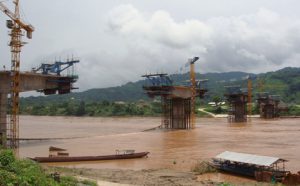The residents of Dangahra, Tajikistan don’t seem to know much about the oil refinery Chinese workers are building in a Special Economic Zone just outside their town, but if they did, they probably wouldn’t have much to say. Dangahra is firmly rooted in Tajik president Emomali Rakhmon’s political heartland, and one of the few places in a republic dependent on wages sent back from workers abroad where jobs are being created for locals. It is an ideal place for China to nestle such a strategic investment.
The facility, which will be operated by 90% stakeholder Dongying Heli Investment and Development, is just piles of building materials at the moment, but when it is completed in 2016 it will aim to supply the domestic market with over 1 million tonnes of petrol and diesel annually, breaking Tajikistan’s dependence on Russian refined fuel products.
Another Chinese refinery of similar scale has already been built in Kara-Balta, an industrial city in energy-poor Kyrgyzstan, and a smaller sister facility is being built in Tokmak, another Kyrgyz city. Crude for these two may eventually come from China’s oil fields in Kyrgyzstan’s northern neighbour, Kazakhstan, while Tajikistan’s refinery could one day be supplied by Tajik crude: China National Petroleum Company are one of several companies exploring major, untapped oil reserves in the republic’s south-west.
These refineries, with a combined capacity of about 2.5 million tonnes, are almost loose change in the context of China’s own demand for oil – roughly 550 million tonnes per year as of next year according to major Chinese oil company Sinopec’s estimations – and will process around a sixth of what China imported via pipeline from Kazakhstan last year. The fact that they will exist largely to satisfy the fairly tiny domestic consumption of the two countries is proof of Beijing’s strategic and nuanced approach to regional energy questions. Kyrgyzstan and Tajikistan are both economically challenged and politically fragile states bordering China’s Xinjiang region, and will play a growing role in the transit of energy to that region from countries further west. Offering them a helping hand in their own battle for energy security is likely to be mutually advantageous.
Although these deals are worth less than US$1 billion (6 billion yuan) in total investments, they are part of the greater narrative of China’s increasing involvement in Central Asian hydrocarbons. The big stories are the contracts worth tens of billions of dollars with oil-rich Kazakhstan and gas-rich Turkmenistan.
Growing relationships
While Central Asia was regarded as an energy-abundant region even in Soviet times, two of its greatest finds occurred after the Republics became independent. The Kashagan oil field in Kazakhstan’s portion of the Caspian sea, discovered in 2000, is the biggest crude find in over three decades. The results of an independent audit of the Galkynysh gas field in Turkmenistan in 2007, meanwhile, catapulted the 5 million-strong Central Asian state into the top four gas-rich countries in the world, making it second only to Qatar in proven gas wealth per capita. These two discoveries, in addition to the significant pre-existing hydrocarbon reserves in both countries gave Beijing a strong incentive to develop ties with Central Asian states based on factors other than the perceived security threat the region posed to Xinjiang.
The problem that both Kazakhstan and Turkmenistan faced in developing energy links with China was transportation. Having been part of a Soviet state that stressed self sufficiency over infrastructural links to the outside world, all pipelines pointed in the direction of Moscow at independence. China has since solved that problem by constructing the China-Kazakhstan pipeline, the first stage of which was inaugurated in 2005, and the China-Turkmenistan gas pipeline, built in record time – 18 months – in 2008.
Neither of these pipelines follow a single trajectory. The China-Kazakhstan pipeline has been built in several stages with further ‘spurs’ possible, perhaps even one moving south towards Kyrgyzstan and the Kara-Balta refinery. Currently connected to more modest, but still significant, oil fields in western Kazakhstan, it will link up with Kashagan – in which CNPC secured a US$5 billion stake last year – after that field comes on line in the near future. The Chinese-Turkmen gas network offers even more potential for dizzying expansion. Built by Chinese companies with cheap Chinese credit it will encompass lines A, B and C, already transporting gas east through Uzbekistan and Kazakhstan, and Line D, agreed upon by China, Uzbekistan, Tajikistan and Kyrgyzstan. This fourth line will take Chinese imports of Turkmen gas up to 65 billion cubic metres per year upon its expected completion in 2016. That China is mulling another offshoot that will skirt through Tajikistan and Afghanistan testifies to the extent to which Beijing is prepared to go to diversify supply routes.
Happily for Turkmenistan, which has waited as other transnational pipeline projects – namely the EU-planned Nabucco project and the TAPI project linking the country to South Asia – make slow progress, Beijing has openly committed to increasing the 5% share of its overall energy consumption occupied by natural gas against more carbon intensive fuels such as coal. Turkmenistan, referred to by one prominent Western scholar on Central Asia as a “de facto Chinese client state”, now has a customer for life.
Finding a place for Moscow
The extent of Chinese involvement in Central Asian energy was made apparent in the run-up to last year’s summit of the Shanghai Cooperation Organization (SCO), an organisation that includes all the Central Asian countries bar Turkmenistan. when Chinese president Xi Jinping signed oil and gas deals worth tens of billions of dollars during a whistle-stop tour of the region. Given that the Shanghai Cooperation Organization also includes Russia, the event offered the perfect opportunity for regionally focused media and analysts to announce Beijing’s usurpation of the Kremlin as the dominant external actor in the region.
Certainly China’s full-scale intervention in local energy markets has hamstrung Russia’s bid to cement its influence in the Central Asia. The refineries in Kyrgyzstan and Tajikistan could shut Russia out of the domestic oil markets of those countries, or, at minimum, reduce it to the humiliating role of supplying Chinese refineries with crude. Before being transformed into a Chinese energy hub, Turkmenistan mostly supplied Russia with gas at knockdown prices, which Moscow subsequently re-exported to Europe at a profit. Now that trade is dying a death and Russian-Turkmen relations are frosty. Kazakhstan remains a key partner to Russia and has positioned itself as a kind of fulcrum to balance Russian and Chinese interests in the region. But Kazakhstan, along with the other countries in Central Asia is demonstrably keener than Russia is on Xi Jinping’s Silk Road Economic Belt, a ratcheted-up programme of Chinese investment in transport links and other infrastructure that will connect Xinjiang and the region to Europe through western Eurasia.
Still, China has not forgotten that Central Asia is loaded with risk as well as opportunity. Chinese policy-makers cannot accurately predict what may happen in Kazakhstan or Uzbekistan once ageing dictators whose families have allegedly amassed fortunes on the back of resource wealth exit the regional scene. The security threats posed to the region by the demographically stretched and occasionally volatile Fergana Valley shared by Kyrgyzstan, Tajikistan and Uzbekistan on the one hand, and potential ‘spillover’ violence from unstable Afghanistan on the other, may both have been exaggerated, but they are there – and so are China’s pipelines.
All of this made the May 21 deal to bring 38 billion cubic metres of gas from Russia to China annually a logical step for Beijing. Signed following the international fallout from Russia’s invasion of the Crimea it is assumed that the terms of the estimated US$40 billion (240 billion yuan) deal were more favourable to China than Russia, Moscow’s diplomatic isolation speeding up the conclusion of an agreement that was years in the making. Yet in the context of China’s westward energy gambit this deal is just another big deal to be followed by potentially bigger ones with the Central Asian states and Russia. What may be most galling for the Kremlin is the idea that China views it neither as an indispensible partner nor as a regional rival of any note, but simply a piece in its increasingly complex and interdependent Eurasian energy security jigsaw.







